




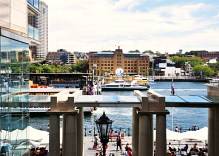
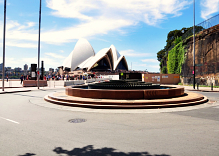
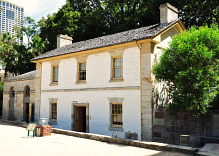
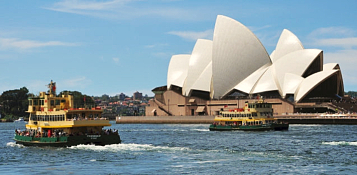
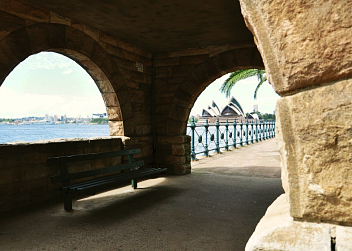
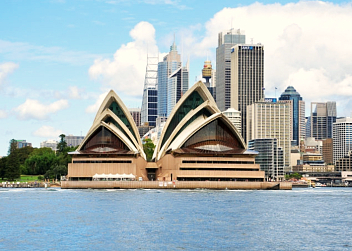
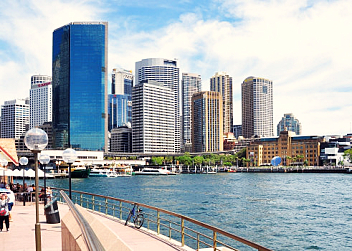
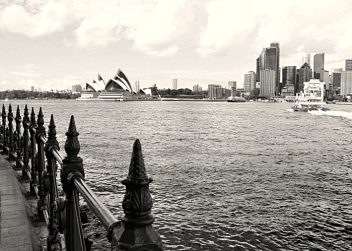
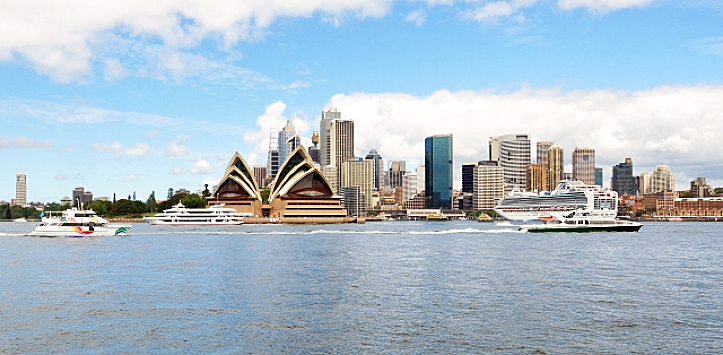


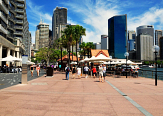
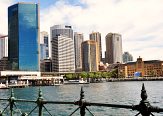
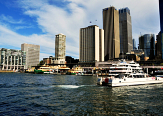
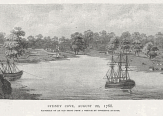

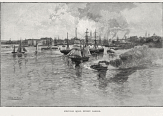

“”Let the start be made from the Circular Quay at an early
hour, just as the great city awakens to another day of
strong-pulsed life and bustling activity. From the mouth of
the bay, a backward glance at the Quay shows the whole
situation, and the contours of Sydney Cove - the chief
water-gate of the city - with its background of stores, is
taken in at one view. The low land at the mouth of the old
Tank Stream was filled in, and a semi-circular wharf
replaced the original shoreline, making a splendid city
front, with an easier gradient tot he main streets than
there is from any other wharf. The whole of this frontage
remains as one property in the hands of the Government,
with the exception of a portion of the north-west side,
originally sold to Mr. Campbell, one of the first merchants
to settle in the colony, and now the wharf of the
Australasian Steam Navigation Company.
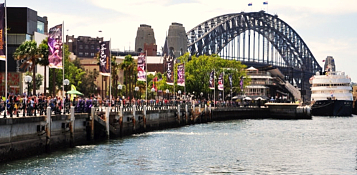












The extreme point on the western side is not a wharf at
all, but a reserve in front of Dawes' Battery, the guns of
which point eastward straight down the harbour; the
grassy slope in front - generally dotted over with
nursemaids and children - makes on a summer
afternoon a pleasant contrast to the adjoining jetties,
steamers and sheds, always alive with strenuous
labour. South of the jetties is the berth occupied by the
Peninsular and Orient boats, one of which is always
lying alongside, the lascars and coolies on deck, with
their red caps and blue smocks, relieving the black hull
with bits of foreign colour, while on the slope of the
land rise the brick red offices of the A.S.N. Company.
South of the P&O. steamer begins the Government
portion of the wharf, with a fine berth for a large vessel,
and behind it may be seen the Sailors' Home, the
Mariners' Church and the Commissariat Store. This
last is one of the oldest stone buildings in the colony,
plain but substantial, built of material quarried on the
spot, and showing that Sydney sandstone can weather
a hundred years of exposure without deterioration.
The centre of the crescent was once ordinary
wharfage, but it has now been entirely given up to
waterman's stairs and for the accommodation of
harbour steamers, the passenger traffic focussing
here, connected as this place is with the tram service
and the omnibus routes. Clustering on the water's
edge, along the dark stone coping of the Quay, are the
waiting-rooms attached to the jetties of the harbour
ferry-boats. On the eastern side, a portion of the wharf
is devoted to outward-bound ships, which load up their
cargoes conveniently from the great produce stores,
separated from the wharf by only the width of the road.
Northward the Orient Company has rented a portion of
the wharf frontage, with one of its covered goods
sheds, and beyond that again lie the boats of the
Messageries Maritimes, lively with foreign uniforms
and costumes, and telling of that intermingling of the
peoples of many lands which follows so closely in the
train of commerce.
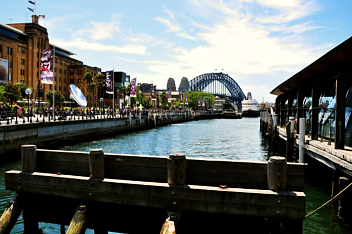
Adjoining this berth is the boatshed of the harbour police,
and next to that the steam ferry for horses and carts, which
plies all day long to Milson's Point. The eastern, like the
western point, is still a public reserve, the site of Fort
Macquarie, one of the ancient structures, but now
destined to give way to a railway shed. Leading up to the
point is a rocky escarpment, the pathway along the summit
of which has received the borrowed name of the Tarpeian
Way.”
Though this description of Sydney Harbour was
written over 100 years ago it is almost relevant today
and is worthy of being read.
From The Picturesque Atlas of Australia by Andrew
Garren
Circular Quay





























